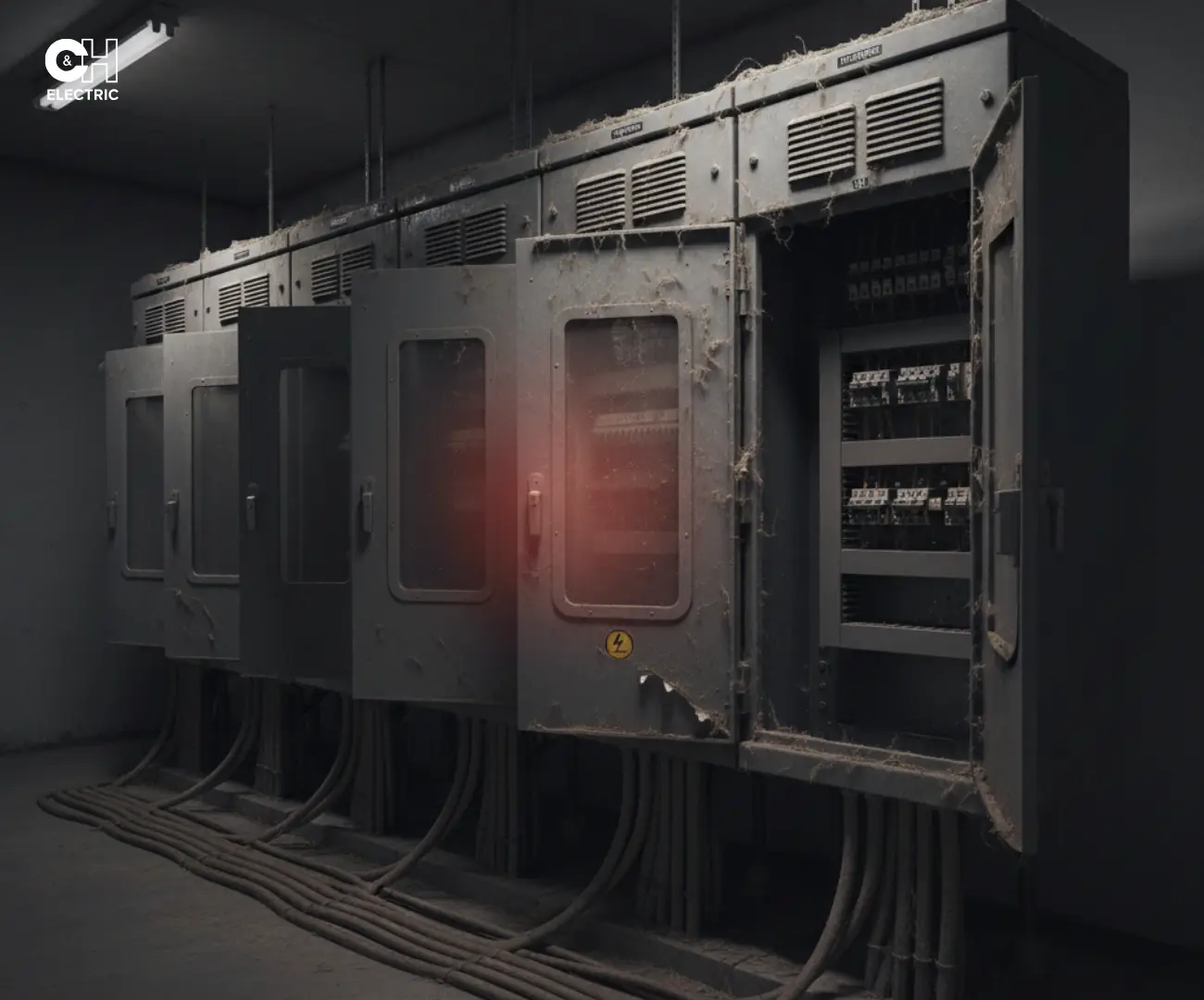
At first glance, dust inside your electrical switchgear may seem harmless — just a housekeeping issue. But in reality, dust is a hidden electrical hazard that can compromise reliability, safety, and compliance.
Dust acts as a conductor, an insulator, and even a fuel source under the wrong conditions. That’s why NFPA 70B (Standard for Electrical Equipment Maintenance) and NFPA 70E (Standard for Electrical Safety in the Workplace) emphasize regular inspection and cleaning as part of preventive maintenance.
Here are the five biggest risks dust creates inside switchgear — and why addressing them should be a priority for every facility.
Dust isn’t just dry particles — it absorbs and retains moisture from the air. This creates a conductive layer on components, which can cause:
- Short circuits.
- Electrical tracking.
- Increased likelihood of arc flash incidents.
Facilities in humid or high-dust environments, such as manufacturing plants or warehouses, face even greater risks.
Dust and moisture are a dangerous combination that increases the risk of electrical failure.
Dust buildup acts like a blanket, preventing insulators, busbars, and other components from releasing heat effectively. The result? Overheating.
Prolonged heat exposure accelerates insulation breakdown, reduces the lifespan of protective devices, and increases the chance of catastrophic failure. For facility managers, this often translates to unexpected downtime and costly repairs.
Arc flash is one of the most dangerous hazards in any facility. Dust significantly increases this risk by creating pathways for flashover between conductors.
When combined with loose or corroded connections, accumulated dust can trigger violent arc flash events that endanger workers and equipment.
Dust can turn minor faults into catastrophic arc flash events.
Protective devices such as relays, breakers, and sensors are designed to trip during faults — but only if they work properly. Dust can infiltrate these components, blocking sensors or jamming mechanical parts.
If a breaker fails to trip during an overload or short circuit, the hazard escalates. Workers, equipment, and the facility itself are left exposed.
This undermines the very foundation of NFPA 70E-compliant electrical safety programs, which depend on reliable protective devices.
Dust doesn’t just create immediate hazards — it accelerates long-term wear. It can:
- Cause corrosion and rust.
- Attract pests and vermin.
- Increase the frequency of repairs and replacements.
Over time, this leads to higher maintenance costs and shorter switchgear lifespan, directly impacting your facility’s bottom line.
Dust isn’t just dirt — it’s a maintenance cost driver.
Ignoring dust isn’t just risky — it can leave your facility out of compliance.
- NFPA 70B (2023): Requires condition-based preventive maintenance, including cleaning.
- NFPA 70E (2024): Requires risk assessments that consider environmental factors like dust.
- OSHA 29 CFR 1910 Subpart S: Employers must maintain electrical equipment in safe operating condition.
Best practices include:
- Infrared thermography to detect overheating caused by dust buildup.
- Regular switchgear cleaning as part of preventive maintenance.
- Documented electrical maintenance programs (EMP) to meet compliance standards.
Many vendors identify dust problems but stop at the report. At C&H Electric, we go further:
- Infrared Thermography – Detect hidden hot spots.
- Preventive Maintenance Programs – Cleaning, lubricating, and torquing.
- NFPA 70E Training – Teaching staff how dust and contaminants increase risks.
- Electrical Maintenance Plans (EMP) – Documentation required under NFPA 70B.
With our full-service approach, we don’t just point out hazards — we fix them to keep your facility safe and compliant.
Partner with the team that not only finds problems — but fixes them.
Protect Your Facility Before OSHA Knocks
Dust inside switchgear is more than a cosmetic issue. It’s a serious safety and reliability risk that can lead to arc flashes, breakdowns, and costly downtime.
Don’t wait until dust causes a failure. Partner with C&H Electric to keep your electrical systems safe, clean, and compliant.
References
- National Fire Protection Association (NFPA). (2023). NFPA 70B: Standard for electrical equipment maintenance (2023 ed.). NFPA.
- National Fire Protection Association (NFPA). (2024). NFPA 70E: Standard for electrical safety in the workplace (2024 ed.). NFPA.
- Occupational Safety and Health Administration (OSHA). (2023). 29 CFR Part 1910 – Subpart S: Electrical standards. U.S. Department of Labor.
- Fluke Corporation. (2022). Infrared thermography for switchgear inspections. Fluke Corporation.
- Safety by Design. (2024). Common OSHA electrical violations and fines. Retrieved from https://www.safetybydesigninc.com/